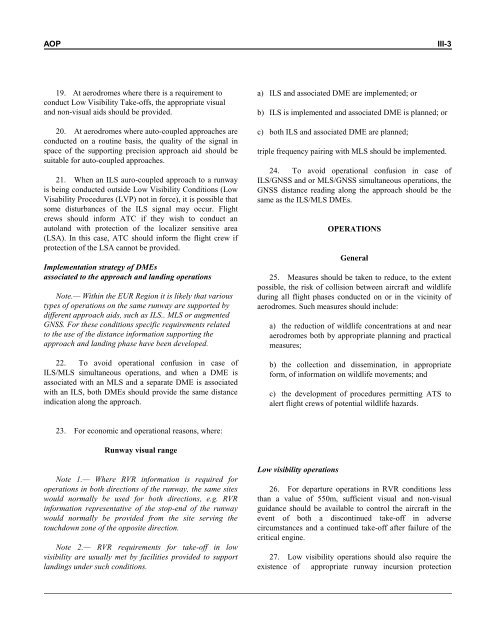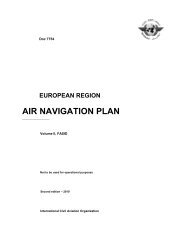7754 Vol 1 Flyleaf - ICAO Public Maps
7754 Vol 1 Flyleaf - ICAO Public Maps
7754 Vol 1 Flyleaf - ICAO Public Maps
You also want an ePaper? Increase the reach of your titles
YUMPU automatically turns print PDFs into web optimized ePapers that Google loves.
AOP III-3<br />
19. At aerodromes where there is a requirement to<br />
conduct Low Visibility Take-offs, the appropriate visual<br />
and non-visual aids should be provided.<br />
20. At aerodromes where auto-coupled approaches are<br />
conducted on a routine basis, the quality of the signal in<br />
space of the supporting precision approach aid should be<br />
suitable for auto-coupled approaches.<br />
21. When an ILS auro-coupled approach to a runway<br />
is being conducted outside Low Visibility Conditions (Low<br />
Visability Procedures (LVP) not in force), it is possible that<br />
some disturbances of the ILS signal may occur. Flight<br />
crews should inform ATC if they wish to conduct an<br />
autoland with protection of the localizer sensitive area<br />
(LSA). In this case, ATC should inform the flight crew if<br />
protection of the LSA cannot be provided.<br />
Implementation strategy of DMEs<br />
associated to the approach and landing operations<br />
Note.— Within the EUR Region it is likely that various<br />
types of operations on the same runway are supported by<br />
different approach aids, such as ILS.. MLS or augmented<br />
GNSS. For these conditions specific requirements related<br />
to the use of the distance information supporting the<br />
approach and landing phase have been developed.<br />
22. To avoid operational confusion in case of<br />
ILS/MLS simultaneous operations, and when a DME is<br />
associated with an MLS and a separate DME is associated<br />
with an ILS, both DMEs should provide the same distance<br />
indication along the approach.<br />
23. For economic and operational reasons, where:<br />
Runway visual range<br />
Note 1.— Where RVR information is required for<br />
operations in both directions of the runway, the same sites<br />
would normally be used for both directions, e.g. RVR<br />
information representative of the stop-end of the runway<br />
would normally be provided from the site serving the<br />
touchdown zone of the opposite direction.<br />
Note 2.— RVR requirements for take-off in low<br />
visibility are usually met by facilities provided to support<br />
landings under such conditions.<br />
a) ILS and associated DME are implemented; or<br />
b) ILS is implemented and associated DME is planned; or<br />
c) both ILS and associated DME are planned;<br />
triple frequency pairing with MLS should be implemented.<br />
24. To avoid operational confusion in case of<br />
ILS/GNSS and or MLS/GNSS simultaneous operations, the<br />
GNSS distance reading along the approach should be the<br />
same as the ILS/MLS DMEs.<br />
OPERATIONS<br />
General<br />
25. Measures should be taken to reduce, to the extent<br />
possible, the risk of collision between aircraft and wildlife<br />
during all flight phases conducted on or in the vicinity of<br />
aerodromes. Such measures should include:<br />
a) the reduction of wildlife concentrations at and near<br />
aerodromes both by appropriate planning and practical<br />
measures;<br />
b) the collection and dissemination, in appropriate<br />
form, of information on wildlife movements; and<br />
c) the development of procedures permitting ATS to<br />
alert flight crews of potential wildlife hazards.<br />
Low visibility operations<br />
26. For departure operations in RVR conditions less<br />
than a value of 550m, sufficient visual and non-visual<br />
guidance should be available to control the aircraft in the<br />
event of both a discontinued take-off in adverse<br />
circumstances and a continued take-off after failure of the<br />
critical engine.<br />
27. Low visibility operations should also require the<br />
existence of appropriate runway incursion protection














